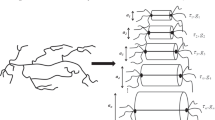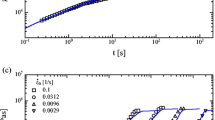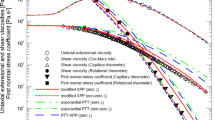Abstract
The molecular stress function (MSF) model is an integral constitutive equation introduced more than two decades ago. It is based on the time-deformation separability principle. The time contribution encloses the linear viscoelastic information, which can be provided by the phenomenological models or any molecular theory. The deformation contribution is defined in the MSF model as a strain measure describing the orientation and the stretch of the strands of the chain as independent processes. The orientation is described by the second-order tensor of the Doi-Edwards model, considering the independent alignment assumption. The stretch is taken into account by the molecular stress function, the main characteristic being that it is included inside the integral and it is the solution of an evolution equation. Since its proposal, the MSF model has been used to describe quantitatively the non-linear rheology of a broad variety of materials such as rubbers, linear and long-chain branched polymer melts and blends of polydisperse samples relevant to the industry. Nearly, monodisperse systems in solution and melt states have also been studied in samples with different structures like linear, bidisperse blends with linear components, combs and pom-pom molecules. Predictions have been obtained for a variety of deformations like uniaxial, equibiaxial and planar extensional flow as well as for steady, medium and large amplitude oscillatory and exponential shear flow. The quantitative description of polymer melts in transient elongation is crucial for numerical simulations. Therefore, the MSF model has been applied to perform finite element simulations for different processes and freesurface deformations, due to its flexibility, reliability and reduced number of material parameters. The integral constitutive equation and its physical interpretation remains the same since it was first published. The evolution equation of the molecular stress function is material dependent because it considers different molecular mechanisms occurring in different structures. Given its importance to rheology, it is the objective of this contribution to review the antecedents, physical basis and applications of the MSF model.






































Similar content being viewed by others
References
Abbasi M, Ebrahimi NG, Nadali M, Esfahani MK (2012) Elongational viscosity of LDPE with various structures: employing a new evolution equation in MSF theory. Rheol Acta 51(2):163–177
Abbasi M, Ebrahimi NG, Wilhelm M (2013) Investigation of the rheological behaviour of industrial tubular and autoclave LDPEs under SAOS, LAOS, transient shear, and elongational flows compared with predictions from the MSF theory. J Rheol 57(6):1693–1714
Ahirwal D, Filipe S, Neuhaus I, Busch M, Schlatter G, Wilhelm M (2014) Large amplitude oscillatory shear and uniaxial extensional rheology of blends from linear and long-chain branched polyethylene and polypropylene. J Rheol 58(3):635–658
Aho J, Rolón-Garrido VH, Syrjälä S, Wagner MH (2010) Extensional viscosity in uniaxial extension and contraction flow—comparison of experimental methods and application of the molecular stress function model. J Non-Newton Fluid Mech 165:212–218
Aho J, Rolón-Garrido VH, Syrjälä S, Wagner MH (2010) Measurement technique and data analysis of extensional viscosity for polymer melts by Sentmanat extensional rheometer (SER). Rheol Acta 49:359–370
Bach A, Almdal K, Rasmussen HK, Hassager O (2003) Elongational viscosity of narrow molar mass distribution polystyrene. Macromolecules 36:5174–5179
Bach A, Rasmussen HK, Longin PY, Hassager O (2002) Growth of non-axisymmetric disturbances of the free surface in the filament stretching rheometer: experiments and simulation. J Non-Newtonian Fluid Mech 108:163–186
Baumgaertel M, Schausberger A, Winter HH (1990) The relaxation of polymers with linear flexible chains of uniform length. Rheol Acta 29:400–408
Bastian H (2001) Non-linear viscoelasticity of linear and long-chainbranched polymer melts in shear and extensional flows, Ph.D. Thesis, Stuttgart University, Germany. http://elib.uni-stuttgart.de/opus/volltexte/2001/894
Booij HC, Palmen JHM (1982) Some aspects of linear and nonlinear viscoelastic behaviour of polymer melts in shear. Rheol Acta 21:376–387
Currie PK (1982a) Constitutive equations for polymer melts predicted by the Doi-Edwards and Curtiss-Bird kinetic theory models. J Non-Newtonian Fluid Mech 11:53–68
Currie PK (1982b) Relationship between extensional and shear properties of polymer melts as predicted by the Doi-Edwards model. Polym Prep 23(2):6–7
de Cindio B (1984) Stress relaxation of polymer melts subjected to large uniaxial tension. Polymer 25:1049–1053
de Gennes PG (1971) Reptation of a polymer chain in the presence of fixed obstacles. J Chem Phys 55:572–579
de Rosa ME, Winter HH (1994) The effect of entanglements on the rheological behaviour of polybutadiene critical gels. Rheol Acta 33:220–237
Dealy JM, Larson RG (2006) Structure and rheology of molten polymers. From structure to flow behavior and back again. Hanser, Germany
Doi M, Edwards SF (1978a) Dynamics of concentrated polymer systems. Part 1. Brownian motion in the equilibrium state. Trans Faraday Soc XX:1789–1801
Doi M, Edwards SF (1978b) Dynamics of concentrated polymer systems. Part 2. Molecular motion under flow. Trans Faraday Soc XX:1802–1817
Doi M, Edwards SF (1978c) Dynamics of concentrated polymer systems. Part 3. The constitutive equations. Trans Faraday Soc XX:1818–1832
Doi M, Edwards SF (1979) Dynamics of concentrated polymer systems. Part 4. Rheological properties. Trans. Faraday Soc XX:38–54
Doi M, Edwards SF (1986) Theory of polymer dynamics. Oxford University Press, Great Britain
Eriksson T, Rasmussen HK (2005) The effects of polymer melt rheology on the replication of surface microstructures in isothermal moulding. J Non-Newtonian Fluid Mech 127:191–200
Ferry JD (1980) Viscoelastic properties of polymers. Wiley, New York
Garritano R, Berting H (2006) Polymer melt and elastomer extension fixture. US Patent No. 7, 096, 728
Gianotti G, Cicuta A, Romanini D (1980) Long chain branching in low-density polyethylene: 1. Molecular structure. Polym 21:1087–1091
Gotsis AD, Zeevenhoven BLF, Tsenoglou C (2004) Effect of long branches on the rheology of polypropylene. J Rheol 48(4):895–914
Graessley WW (1982) Entangled linear, branched and network polymer systems—molecular theories. Adv Polym Sci 47:67–117
Gumbrell SM, Mullnis L, Rivlin RS (1953) Departures of the elastic behaviour of rubbers in simple extension from the kinetic theory. Trans Faraday Soc 49:1495–1505
Hadinata C, Boss D, Gabriel C, Wassner E, Rüllmann M, Kao N, Laun M (2007) Elongation-induced crystallization of a high molecular weight isotactic polybutene-1 melt compared to shear-induced crystallization. J Rheol 51(2):195–215
Hassager O, Hansen R (2010) Constitutive equations for the Doi-Edwards model without independent alignment. Rheol Acta 49(6):555–562
Hassanabadi HM, Abbasi M, Wilhelm M, Rodrigue D (2013) Validity of the modified molecular stress function theory to predict the rheological properties of polymer nanocomposites. J Rheol 57(3):881–899
Huang Q, Rasmussen HK, Skov AL, Hassager O (2012) Stress relaxation and reversed low of low-density polyethylene melts following uniaxial extension. J Rheol 56(6):1535–1554
Hyun K, Wilhelm M (2009) Establishing a new mechanical nonlinear coefficient Q from FT-rheology: first investigation of entangled linear and comb polymer systems. Macromolecules 42:411–422
Ianniruberto G, Marrucci G (1996) On compatibility of the Cox-Merz rule with the model of Doi and Edwards. J Non-Newtonian Fluid Mech 65:241–246
Ianniruberto G, Marrucci G (2014) Convective constraint release (CCR) revisited. J Rheol 58:89–102
Isaki T, Takahashi M, Urakawa O (2003) Biaxial damping function of entangled monodisperse polystyrene melts: comparison with the Mead-Larson-Doi model. J Rheol 47:1201–1210
Janeschitz-Kriegl H (1983) Polymer melt rheology and flow birefringence. Springer, Berlin
Kharlamov AA, Filip P (2012) On the generalised stretch function. Macromol Theory Simul 21:272–278
Kheirandish S, Stadlbauer M (2009) Molecular stress function theory and analysis of branching structure in industrial polyolefins. J Therm Anal Calorim 98(3):629–637
Kim DM, Busch M, Hoefsloot HCJ, Iedema PD (2004) Molecular weight distribution modeling in low-density polyethylene polymerization; impact of scission mechanisms in the case of CSTR. Chem Eng Sci 59:699–718
Kuhn R, Krömer H (1982) Structures and properties of different low density polyethylenes. Colloid Polym Sci 260:1083–1092
Larson RG (1988) Constitutive equations for polymer melts and solutions. Buttherworth, USA
Lagendijk RP, Hogt AH, Buijtenhuijs A, Gotsis AD (2001) Peroxydicarbonate modification of polypropylene and extensional flow properties. Polymer 42:10035–10043
Leblans PJR (1987) Nonlinear viscoelasticity of polymer melts in different types of flow. Rheol Acta 26:135–143
Lyhne A, Rasmussen HK, Hassager O (2009) Simulation of elastic rupture in extension of entangled monodisperse polymer melts. Phys Rev Lett 102:138301
Malkin AY, Isayev AI (2006) Rheology, concepts, methods and applications. ChemTec Publisching, Toronto
Marín JMR, Rasmussen HK (2009) Lagrangian finite-element method for the simulations of K-BKZ fluids with third order accuracy. J Non-Newtonian Fluid Mech 156:177–188
Marrucci G (1996) Dynamics of entanglements: a nonlinear model consistent with the Cox-Merz rule. J Non-Newtonian Fluid Mech 62:279–289
Marrucci G, de Cindio B (1980) The stress relaxation of molten PMMA at large deformations and its theoretical interpretation. Rheol Acta 19:68–75
Marrucci G, Hermans JJ (1980) Nonlinear viscoelasticity of concentrated polymeric liquids. Macromolecules 13:380–387
Marrucci G, Grizzuti N (1983) The free energy function of the Doi-Edwards theory: analysis of the instabilities in stress relaxation. J Rheol 27:433–450
Marrucci G, Ianniruberto G (2004) Interchain pressure effect in extensional flows of entangled polymer melts. Macromolecules 37:3934–3942
McKinley GH, Sridhar T (2002) Filament-stretching rheometry of complex fluids. Annu Rev Fluid Mech 34:375–415
McLeish TCB, Larson RG (1998) Molecular constitutive equations for a class of branched polymers: the pom-pom polymer. J Rheol 42(1):81–110
Menezes EV, Graessley WW (1982) Nonlinear rheological behavior of polymer systems for several shear-flow histories. Polym Phys 20:1817–1833
Mooney M (1940) A theory of large elastic deformation. J Appl Phys 11:582–592
Nielsen JK, Rasmussen HK, Denberg M, Almdal K, Hassager O (2006) Nonlinear branch-point dynamics of multiarm polystyrene. Macromolecules 39:8844–8853
Münstedt H, Laun HM (1979) Elongational behaviour of low density polyethylene melt II. Transient behaviour in constant stretching rate and tensile creep experiments. Comparison with shear data. Temeprature dependence of the elongational properties. Rheol Acta 18:492–504
Nielsen JK, Rasmussen HK (2008) Reversed extension flow. J Non-Newtonian Fluid Mech 155:15–19
Nielsen JK, Rasmussen HK, Hassager O (2008) Stress relaxation of narrow molar mass distribution polystyrene following uniaxial extension. J Rheol 52(4):885–899
Öttinger HC (2005) Beyond equilibrium thermodynamics. Wiley, New York
Ogura K, Wagner MH (2013) Rheological characterization of cross-linked poly(methyl methacrylate). Rheol Acta 52(8–9):753–765
Olley P (2005) A study of the quadratic molecular stress function constitutive model in simulation. J Non-Newtonian Fluid Mech 125:171–183
Olley P, Wagner MH (2006) A modification of the convective constraint release mechanism in the molecular stress function model giving enhanced vortex growth. J Non-Newtonian Fluid Mech 135:68–91
Osaki K, Nishizawa K, Kurata M (1982) Material time constant characterizing the nonlinear viscoelasticity of entangled polymeric systems. Macromolecules 15:1068–1071
Pearson DS, Kiss AD, Fetters LJ, Doi M (1989) Flow-induced birefringence of concentrated polyisoprene solutions. J Rheol 33(3):517–535
Pearson DS, Kiss AD, Fetters LJ, Doi M (1990) Erratum: Flow-induced birefringence of concentrated polyisoprene solutions [J. Rheol. 33(3), 517-535]. J Rheol 34(4):613
Raave A (2012) Principles of polymer chemistry. Springer, New York
Rasmussen HK (2002) Lagrangian viscoelastic flow computations using a generalized molecular stress function model. J Non-Newtonian Fluid Mech 106:107–120
Rasmussen HK (2013) Catastrophic failure of polymer melts during extension. J Non-Newtonian Fluid Mech 198:136–140
Rasmussen HK, Nielsen JK, Bach A, Hassager O (2005) Viscosity overshoot in the start-up of uniaxial elongation of low density polyethylene melts. J Rheol 49(2):369–381
Rasmussen HK, Bach A (2005) On the bursting of linear polymer melts in inflation process. Rheol Acta 44:435–445
Rasmussen HK, Eriksson T (2007) Gas displacement of polymer melts in a cylinder: experiments and viscoelastic simulations. J Non-Newtonian Fluid Mech 143:1–9
Rasmussen HK, Yu K (2008) On the burst of branched polymer melts during inflation. Rheol Acta 47:149–157
Rasmussen HK, Yu K (2011) Spontaneous breakup of extended monodisperse polymer melts. Phys Rev Lett 107:126001
Rasmussen HK, Huang Q (2014a) The missing link between the extensional dynamics of polymer melts. J Non-Newtonian Fluid Mech 204:1–6
Rasmussen HK, Huang Q (2014b) Interchain tube pressure effect in extensional flows of oligomer diluted nearly monodisperse polystyrene melts. Rheol Acta 53:199–208
Rasmussen HK, Laillé P, Yu K (2008) Large amplitude oscillatory elongation flow. Rheol Acta 47:97–103
Rasmussen HK, Skov AL, Nielsen JK, Laillé P (2009) Elongational dynamics of multiarm polystyrene. J Rheol 53(2):401–415
Rivlin RS (1948) Large elastic deformations of isotropic materials. 4. Further developments of the general theory. Philos Trans R Soc (London) Ser A 241:379–397
Rolón-Garrido VH, Wagner MH, Luap C, Schweizer T (2006) Modeling non-Gaussian extensibility effects in elongation of nearly monodisperse polystyrene melts. J Rheol 50(3):327–340
Rolon-Garrido VH, Wagner MH (2007) The MSF model: relation of nonlinear parameters to molecular structure of long-chain branched polymer melts. Rheol Acta 46:583–594
Rolón-Garrido VH, Wagner MH (2009) The damping function in rheology. Rheol Acta 48:245–284
Rolón-Garrido VH, Wagner MH (2014a) Linear and non-linear rheological characterization of photo-oxidative degraded LDPE. Polym Degrad Stabil 99:136–145
Rolón-Garrido VH, Wagner MH (2014b) Elongational rheology and cohesive fracture of photo-oxidated LDPE. J Rheol 58(1):199–222
Rolón-Garrido VH, Pivokonsky R, Filip P, Zatloukal M, Wagner MH (2009) Modelling elongational and shear rheology of two LDPE melts. Rheol Acta 48:691–697
Rolón-Garrido VH, Luo J, Wagner MH (2011) Enhancement of strain-hardening by thermo-oxidative degradation of low-density polyethylene. Rheol Acta 50:519–535
Rolón-Garrido VH, Zatloukal M, Wagner MH (2013) Increase of long-chain branching by thermo-oxidative treatment of LDPE: chromatographic, spectroscopic and rheological evidence. J Rheol 57(1):105–129
Schieber JD, Indei T, Steenbakkers RJA (2013) Fluctuating entanglements in single-chain mean-field models. Polymers 5:643–678
Sentmanat M (2004) Miniature universal testing platform: from extensional melt rheology to solid-state deformation behaviour. Rheol Acta 43:657–669
Takahashi M, Isaki T, Takigawa T, Masuda T (1993) Measurement of biaxial and uniaxial extensional flow behavior of polymer melts at constant strain rates. J Rheol 37:827–846
Thévenon A, Fulchiron R (2013) Elongational behaviour of amorphous polymers in the vicinity and above the glass transition temperature. Polym Test 32:691–700
van Ruymbeke E, Bailly C, Keunings R, Vlassopoulos D (2006) A general methodology to predict the linear rheology of branched polymers. Macromolecules 39:6248–6259
Voyiatzis E, Tsenoglou CJ, Boudouvis AG (2009) On Hadamard stability and dissipative stability of the molecular stress function model of non-linear viscoelasticity. Int J Non-Linear Mech 44:727–734
Wagner MH (1976) Analysis of time-dependent non-linear stress-growth data for shear and elongational flow of a low-density branched polyethylene melt. Rheol Acta 15:136–142
Wagner MH (1978) A constitutive analysis of uniaxial elongational flow data of a low-density polyethylene melt. J Non-Newtonian Fluid Mech 4:39–55
Wagner MH, Stephenson SE (1979a) The spike-strain test for polymeric liquids and its relevance for irreversible destruction of network connectivity by deformation. Rheol Acta 18:463–468
Wagner MH, Stephenson SE (1979b) The irreversibility assumption of network disentanglement in flowing polymer melts and its effects on elastic recoil predictions. J Rheol 23(4):489–504
Wagner MH (1990) The nonlinear strain measure of polyisobutylene melt in general biaxial flow and its comparison to the Doi-Edwards model. Rheol Acta 29:594–603
Wagner MH, Demarmels A (1990) A constitutive analysis of extensional flows of polyisobutylene. J Rheol 34(6):943–957
Wagner MH (1992) The slip-link model: a constitutive equation for general biaxial extension of polymer melts. Makromol Chem Macromol Symp 56:13–24
Wagner MH (1999) Constitutive equations for polymer melts and rubbers: lessons from the 20th century. Korea-Australia Rheol J 11(4):293–304
Wagner MH, Meissner J (1980) Network disentanglement and time-dependent flow behaviour of polymer melts. Makromol Chem 181:1533–1550
Wagner MH, Schaeffer J (1992a) Constitutive equations from Gaussian slip-link network theories in polymer melt rheology. Rheol Acta 31:22–31
Wagner MH, Schaeffer J (1992b) Nonlinear measures for general biaxial extension of polymer melts. J Rheol 36(1):1–26
Wagner MH (1993) The nonlinear strain measure of polymer melts and rubbers: a unifying approach. Makromol Chem Macromol Symp 68:95–108
Wagner MH, Schaeffer J (1993) Rubbers and polymer melts: universal aspects of nonlinear stress-strain relations. J Rheol 37(4):643–661
Wagner MH (1994a) Analysis of small angle neutron scattering data on poly(dimethylsiloxane) network unfolding. Macromolecules 27:5223–5226
Wagner MH (1994b) The origin of the C 2 term in rubber elasticity. J Rheol 38(3):655–679
Wagner MH (2011) The effect of dynamic tube dilation on chain stretch in nonlinear polymer melt rheology. J Non-Newtonian Fluid Mech 166:915–924
Wagner MH, Schaeffer J (1994) Assessment of nonlinear strains measures for extensional and shearing flows of polymer melts. Rheol Acta 33:506–516
Wagner MH, Geiger K (1997) The role of the orientation tensor in the rheology of flexible polymers. Macromol Theor Simul 6:703–711
Wagner MH, Ehrecke P (1998) Dynamics of polymer melts in reversing shear flows. J Non-Newtonian Fluid Mech 76:183–197
Wagner MH, Ehrecke P, Hachmann P, Meissner J (1998a) A constitutive analysis of uniaxial, equibiaxial and planar extension of a commercial linear high-density polyethylene melt. J Rheol 42(3):621–638
Wagner MH, Bastian H, Ehrecke P, Kraft M, Hachmann P, Meissner J (1998b) Nonlinear viscoelastic characterization of a linear polyethylene (HDPE) melt in rotational and irrotational flows. J Non-Newt Fluid Mech 79:283–296
Wagner MH, Bastian H, Hachmann P, Meissner J, Kurzbeck S, Münstedt H, Langouche F (2000) The strain-hardening behaviour of linear and long-chain-branched polyolefin melts in extensional flows. Rheol Acta 39:97–109
Wagner MH, Rubio P, Bastian H (2001) The molecular stress function model for polydisperse polymer melts with dissipative convective constraint release. J Rheol 45(6):1387–1412
Wagner MH, Bastian H, Bernnat A, Kurzbeck S, Chai CK (2002) Determination of elongational viscosity of polymer melts by RME and Rheotens experiments. Rheol Acta 41:316–325
Wagner MH, Yamaguchi M, Takahashi M (2003) Quantitative assessment of strain hardening of low-density polyethylene melts by the molecular stress function model. J Rheol 47(3):779–793
Wagner MH, Kheirandish S, Yamaguchi M (2004a) Quantitative analysis of melt elongational behavior of LLDPE/LDPE blends. Rheol Acta 44:198–218
Wagner MH, Hepperle J, Münstedt H (2004b) Relating rheology and molecular structure of model branched polystyrene melts by molecular stress function theory. J Rheol 48(3):489–503
Wagner MH, Kheirandish S, Koyama K, Nishioka A, Minegishi A, Takahashi T (2005a) Modeling strain hardening of polydisperse polystyrene melts by molecular stress function theory. Rheol Acta 44:235–243
Wagner MH, Kheirandish S, Hassager O (2005b) Quantitative prediction of transient and steady-state elongational viscosity of nearly monodisperse polystyrene melts. J Rheol 49:1317–1327
Wagner MH, Kheirandish S, Stange J, Münstedt H (2006) Modeling elongational viscosity of blends of linear and long-chain branched propylenes. Rheol Acta 46(2):211–221
Wagner MH, Rolón-Garrido VH (2010) The interchain pressure effect in shear rheology. Rheol Acta 49:459–471
Wagner MH, Rolón-Garrido VH, Chai CK (2005) Exponential shear flow of branched polyethylenes in rotational parallel-plate geometry. Rheol Acta 45:164–173
Wagner MH, Rolón-Garrido VH, Nielsen JK, Rasmussen HK, Hassager O (2008a) A constitutive analysis of transient and steady-state elongational viscosities of bidisperse polystyrene blends. J Rheol 52(1):67–86
Wagner MH, Rolón-Garrido VH (2008b) Verification of branch point withdrawal in elongational flow of pom-pom polystyrene melt. J Rheol 52(5):1049–1068
Wagner MH, Rolón-Garrido VH (2009) Nonlinear rheology of linear polymer melts: modeling chain stretch by interchain tube pressure and Rouse time. Korea-Australia Rheol J 21(4):203–211
Wagner MH, Rolón-Garrido VH, Hyun K, Wilhelm M (2011) Analysis of medium amplitude oscillatory shear data of entangled linear and model comb polymers. J Rheol 55(3):495–516
Wapperom P, Leygue A, Keunings R (2005) Numerical simulation of large amplitude oscillatory shear of a high-density polyethylene melt using the MSF model. J Non-Newtonian Fluid Mech 130:63–76
Winter HH, Mours M (1997) Rheology of polymers near liquid-solid transitions. Adv Polym Sci 134:165–234
Ye X, Sridhar T (2005) Effects of the polydispersity on rheological properties of entangled polystyrene solutions. Macromolecules 38:3442–3449
Yu K, Marín JMR, Rasmussen HK, Hassager O (2010) 3D modeling of dual wind-up extensional rheometers. J Non-Newtonian Fluid Mech 165(1–2):14–23
Yu K, Rasmussen HK, Marín JMR, Hassager O (2011) The dynamics of cylindrical samples in dual wind-up extensional rheometers. J Rheol 55(3):571–580
Yu K, Rasmussen HK, Román-Marín JM, Hassager O (2012) Mechanism of spontaneous hole formation in thin polymeric films. Phys Rev B 85:024201
Acknowledgments
Financial support by the German Science Foundation (DFG) is gratefully acknowledged.
Author information
Authors and Affiliations
Corresponding author
Additional information
Dedicated to Professor Manfred H. Wagner on the occasion of his 65th birthday.
Rights and permissions
About this article
Cite this article
Rolón-Garrido, V.H. The molecular stress function (MSF) model in rheology. Rheol Acta 53, 663–700 (2014). https://doi.org/10.1007/s00397-014-0787-x
Received:
Revised:
Accepted:
Published:
Issue Date:
DOI: https://doi.org/10.1007/s00397-014-0787-x




